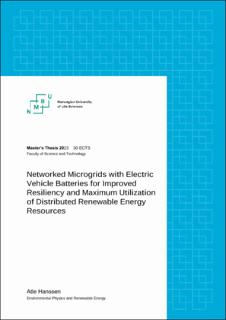| dc.description.abstract | In today’s distribution grid, issues have emerged due to the increasing energy production from distributed energy resources such as photovoltaic systems. As the distribution grid is not designed for large-scale production that can lead to bidirectional power flow, problems with voltage regulation, power quality, grid instability, and electrical problems in transformers may arise [1]. Today’s power grid is also vulnerable to power outages due to faults in the grid or targeted attacks against the power grid. With the implementation of networked microgrids, one can reach a higher energy supply provision to critical loads during disconnection from the utility grid.
This master’s thesis models and studies a networked microgrid with the aim of highlighting how such grids can increase the resilience of the power grid and how to maximize the use of distributed energy resources. The thesis also focuses on how the battery capacity of electric vehicles can be utilized in the power grid. A case study is designed and modeled to examine these questions in Simulink. The case study examines the resiliency of networked microgrids in comparison to nonnetworked microgrids and consists of three interconnected microgrids. The first microgrid houses a hospital, the second accommodates an office building, and the third includes a residential area. All microgrids contain photovoltaic systems for energy production, electric vehicles for energy storage, and varying loads. 40 % of the load demand in the hospital is defined as critical loads and should be prioritized in case of power outages. Three different scenarios have been simulated and compared. In the first scenario representing a normal operation, the microgrids are interconnected to each other as well as the utility grid. In the second scenario, there is a power outage in the utility grid, and all microgrids are disconnected from each other. This results in all the microgrids operating in islanded mode. In the third and final scenario, a power outage in the utility power grid results in networked microgrid operation where the microgrids exchange power among themselves. The main objective is to supply the critical loads in the hospital with continuous power flow.
The results indicated that networked microgrid operation enhances resilience, achieves a higher utilization of distributed energy resources, and validates the feasibility of using electric vehicles as energy storage systems compared to islanded mode operation. The duration of limited power supply to the critical loads decreased by 69.2 %. The total time with load shedding was reduced by 12.3 %, and the maximum load shed value was reduced from 88.7 % to 66.6 %. Further, photovoltaic production increased by 143.7 % in networked microgrid operation compared to operation in islanded mode. Utilizing electric vehicles as energy storage can increase flexibility and can yield a high storage capacity during periods of high demand. However, during periods
of low demand, such as nighttime, it may provide a small and sometimes insufficient storage capacity.
This work can be enhanced by implementing electricity prices and the use of Mixed-Integer Linear Programming to optimize power flow between each microgrid and between the microgrids and the utility grid. However, due to the time limitations of this master’s thesis, these measurements had to be excluded. | |
